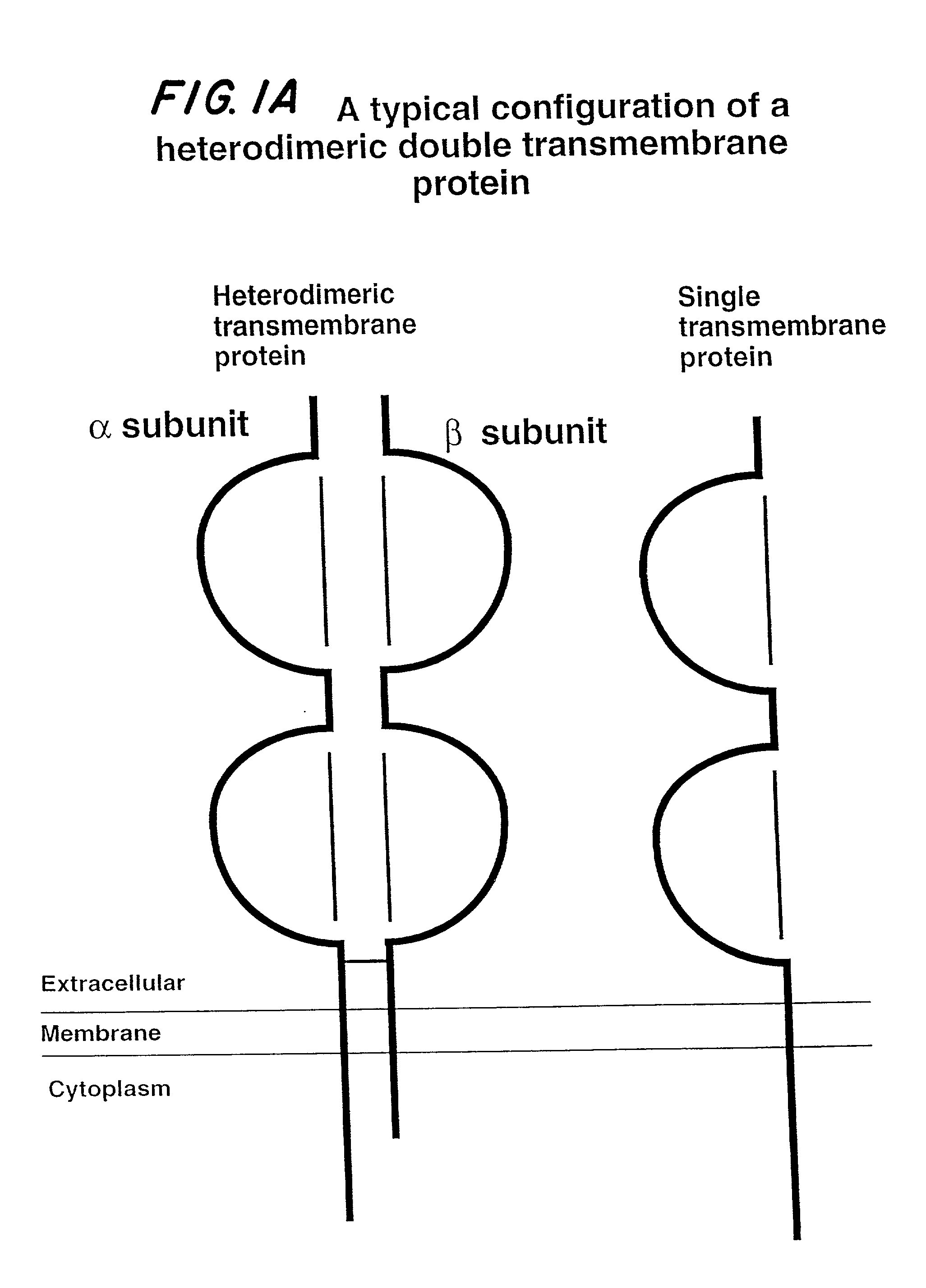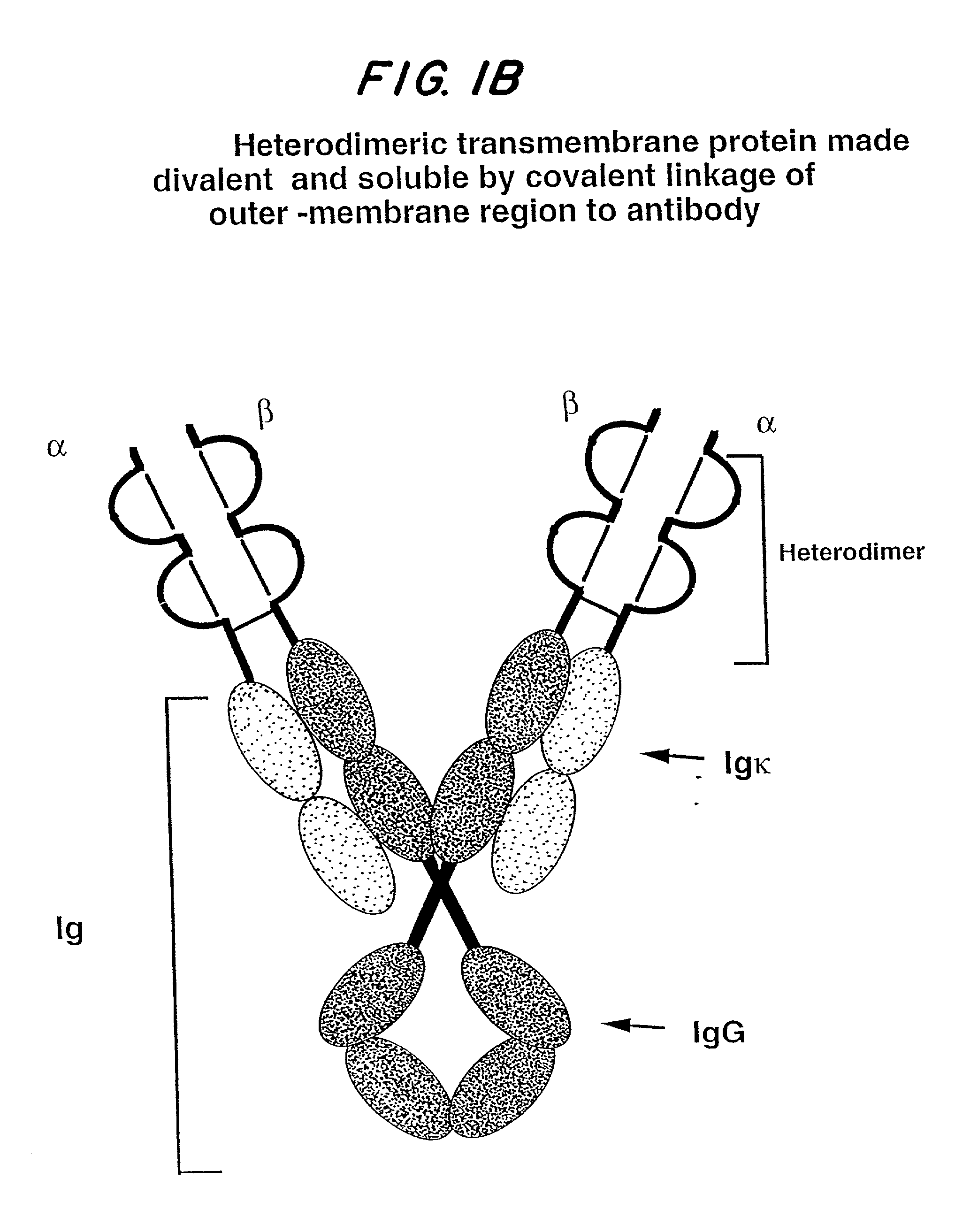Soluble divalent and multivalent heterodimeric analogs of proteins
a heterodimeric analog and protein technology, applied in the field of soluble divalent and multivalent heterodimeric analogs of proteins, can solve the problems of ineffective immune response specificity and avidity, simple soluble monovalent analogs of t cell receptors or peptide/mhc complexes that do not have the required specificity and avidity, and achieve enhanced binding affinity for modulating immune responses, and facilitate their characterization
- Summary
- Abstract
- Description
- Claims
- Application Information
AI Technical Summary
Benefits of technology
Problems solved by technology
Method used
Image
Examples
example 1
Construction and Expression of Soluble Divalent Class II MHC Molecules and T Cell Receptors
[0091] The difficulty experienced with the construction and expression of soluble heterodimeric integral proteins, such as soluble divalent class II MHC molecules and T cell receptors (TcRs), was overcome by linking .alpha. and .beta. chain polypeptides to immunoglobulin heavy and light chains (FIGS. 1 and 2). Using the soluble divalent TcRs, data are presented to show that soluble proteins are high affinity ligands for peptide / MHC complexes.
[0092] TcR Rationale and Construction:
[0093] The 2C TcR was selected to generate soluble divalent TcR analogs. 2C is a well characterized alloreactive, peptide-specific cytotoxic T lymphocyte (CTL) clone (Kranz et al Proc Natl Acad Sci USA 81:573-577 (1984). This clone is specific for a naturally processed endogenous peptide derived from alpha-ketoglutarate dehydrogenase bound by the murine class I molecule H-2L.sup.d (Udaka et al Cell 69:989-998 (1992). T...
example 2
Detection of Soluble Heterodimeric Proteins
[0104] Cells infected with baculovirus containing transfer vectors encoding the soluble chimeric Ig constructs described above secrete a soluble chimeric Ig-like molecule detected by specific ELISA assays 4-5 days post infection. For 2C TcR / IgG, the assay was based on a primary antibody specific for murine IgG1 Fc (plated at 10 .mu.g / ml) and a biotinylated secondary antibody, H57 (used at 1:5000 final dilution), specific for a conformational epitope expressed on the .beta. chain of many TcR (FIG. 5, Panel A) or biotinylated 1B2 or a monoclonal antibody specific for a clontoypic epitope expressed on 2C TcR (FIG. 5, Panel B). For detection of I-E / IgG chimeric molecules, the same primary antibody was used and the biotinylated secondary antibody was 14.4.4, which is specific for I-E.alpha. chain (FIG. 5, Panel C). Supernatants from infected cells were incubated for 1 hour at room temperature. Plates were washed extensively with phosphate buffer...
example 3
Affinity measurements of soluble divalent TCR interaction with peptide / MHC complexes.
[0107] A competitive inhibition assay was developed to measure the affinity of soluble 2C TCR / Ig for peptide / MHC complexes. This assay, similar to one previously used to determine the affinity of soluble monovalent 2C TCR for peptide / MHC complexes (Schlueter et al Journal of Molecular Biology 256:859-869 (1996), is based on mAb 30.5.7 binding to a region of the a2 helix of H-2 Ld that overlaps with TCR receptor binding (Solheim et al Journal of Immunology 154:1188-1197 (1995); Solheim et al Journal of Immunology 150:800-811 (1993). Briefly, affinities of 30.5.7 Fab fragments for RMA-S L.sup.d cells were determined by direct saturation analysis of 30.5.7 Fab binding to cells analyzed by flow cytometry. Cells were incubated with increasing amounts of FITC labeled 30.5.7 Fab, and K.sub.d's were estimated from a plot of 1 / MCF vs. 1 / [30.5.7 Fab]. Affinities of 2C TCR analogs were determined by competitio...
PUM
| Property | Measurement | Unit |
|---|---|---|
| concentration | aaaaa | aaaaa |
| volume | aaaaa | aaaaa |
| concentration | aaaaa | aaaaa |
Abstract
Description
Claims
Application Information
 Login to View More
Login to View More - R&D
- Intellectual Property
- Life Sciences
- Materials
- Tech Scout
- Unparalleled Data Quality
- Higher Quality Content
- 60% Fewer Hallucinations
Browse by: Latest US Patents, China's latest patents, Technical Efficacy Thesaurus, Application Domain, Technology Topic, Popular Technical Reports.
© 2025 PatSnap. All rights reserved.Legal|Privacy policy|Modern Slavery Act Transparency Statement|Sitemap|About US| Contact US: help@patsnap.com



